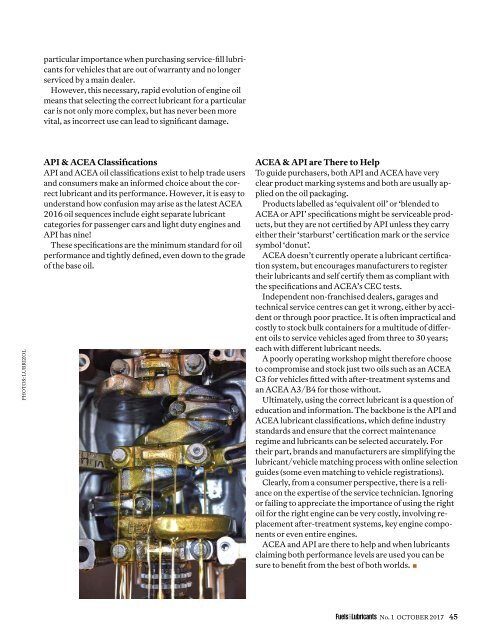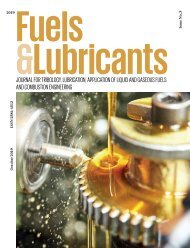Fuels & Lubricants Magazine
Issue 1, October 2017
Issue 1, October 2017
You also want an ePaper? Increase the reach of your titles
YUMPU automatically turns print PDFs into web optimized ePapers that Google loves.
particular importance when purchasing service-fill lubricants<br />
for vehicles that are out of warranty and no longer<br />
serviced by a main dealer.<br />
However, this necessary, rapid evolution of engine oil<br />
means that selecting the correct lubricant for a particular<br />
car is not only more complex, but has never been more<br />
vital, as incorrect use can lead to significant damage.<br />
PHOTOs: LUBRIZOL<br />
API & ACEA Classifications<br />
API and ACEA oil classifications exist to help trade users<br />
and consumers make an informed choice about the correct<br />
lubricant and its performance. However, it is easy to<br />
understand how confusion may arise as the latest ACEA<br />
2016 oil sequences include eight separate lubricant<br />
categories for passenger cars and light duty engines and<br />
API has nine!<br />
These specifications are the minimum standard for oil<br />
performance and tightly defined, even down to the grade<br />
of the base oil.<br />
ACEA & API are There to Help<br />
To guide purchasers, both API and ACEA have very<br />
clear product marking systems and both are usually applied<br />
on the oil packaging.<br />
Products labelled as ‘equivalent oil’ or ‘blended to<br />
ACEA or API’ specifications might be serviceable products,<br />
but they are not certified by API unless they carry<br />
either their ‘starburst’ certification mark or the service<br />
symbol ‘donut’.<br />
ACEA doesn’t currently operate a lubricant certification<br />
system, but encourages manufacturers to register<br />
their lubricants and self certify them as compliant with<br />
the specifications and ACEA’s CEC tests.<br />
Independent non-franchised dealers, garages and<br />
technical service centres can get it wrong, either by accident<br />
or through poor practice. It is often impractical and<br />
costly to stock bulk containers for a multitude of different<br />
oils to service vehicles aged from three to 30 years;<br />
each with different lubricant needs.<br />
A poorly operating workshop might therefore choose<br />
to compromise and stock just two oils such as an ACEA<br />
C3 for vehicles fitted with after-treatment systems and<br />
an ACEA A3/B4 for those without.<br />
Ultimately, using the correct lubricant is a question of<br />
education and information. The backbone is the API and<br />
ACEA lubricant classifications, which define industry<br />
standards and ensure that the correct maintenance<br />
regime and lubricants can be selected accurately. For<br />
their part, brands and manufacturers are simplifying the<br />
lubricant/vehicle matching process with online selection<br />
guides (some even matching to vehicle registrations).<br />
Clearly, from a consumer perspective, there is a reliance<br />
on the expertise of the service technician. Ignoring<br />
or failing to appreciate the importance of using the right<br />
oil for the right engine can be very costly, involving replacement<br />
after-treatment systems, key engine components<br />
or even entire engines.<br />
ACEA and API are there to help and when lubricants<br />
claiming both performance levels are used you can be<br />
sure to benefit from the best of both worlds.







